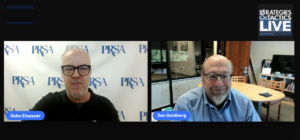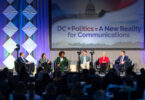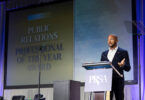“The percentage of consumers today who are looking to do business with organizations that support and believe the same things they do continues to grow,” Jon Goldberg said. Brands are under pressure to make statements on divisive social issues or be “lined up for public cancellation.”
Goldberg, founder and chief reputation architect of Reputation Architects, a communications firm in Roseland, N.J., was the guest on May 30 for Strategies & Tactics Live, PRSA’s monthly livestream series on LinkedIn.
Although some polls suggest otherwise, among the millennials who are now the dominant generation in the marketplace and workplace, “their expectation is to hear from organizations that employ them, organizations they do business with, organizations they support, to know what those organizations are thinking around issues that are important to them and their communities.”
Companies and brands should be prepared, “rather than wait until the spotlight is on them to think things through and create a plan,” he said. Organizations need to “draw some guardrails for themselves on the various issues — what they might say, where they believe they potentially have license to weigh in.”
At the same time, companies should understand those issues on which it’s probably better not to take a public stance, he said. But it’s the stakeholders, not the organization’s leaders, who hold the power to decide whether a company should speak out and what its stance should be.
John Elsasser, editor-in-chief of PRSA’s Strategies & Tactics and host of S&T Live, asked whether there’s a tipping point at which stakeholder expectations about companies commenting on divisive social issues becomes unreasonable.

“Reasonableness is in the eye of the beholder,” Goldberg said. Stakeholders will decide whether taking a stance on a hot-button issue is reasonable or not, he said.
“Business is not going to convince [its customers, employees, etc.] that their interests and their questions and their desire to hear from organizations and leaders are unreasonable,” he said. So an organization deciding for itself whether it’s reasonable to speak out “is potentially very dangerous.”
Torches and pitchforks
“Once stakeholders start coming at an organization with their torches and pitchforks, it is too late to do that kind of thoughtful analysis and make well-informed risk decisions,” Goldberg said. At that point, organizations and leaders are making decisions “fueled by fear,” which he calls “the number one cause of self-inflicted wounds. It’s easy to misspeak.”
He recommends that an organization’s leaders identify the social issues on which they might be cornered to comment, issues that stakeholders and employees consider important — while keeping in mind that stakeholders won’t all agree. How do those issues relate to the organization’s mission, strategy or values? What might the organization want — or be forced — to say on those topics?
In the process, the company can also “map out any lines the organization believes it’s best not to cross,” he said. Before making a public comment that will please some people and alienate others, organizations should “analyze down to dollars and cents” the risks to their business, balance sheet and reputation.
You can listen to a playback of the session here.
Illustration credit: betterpickart







